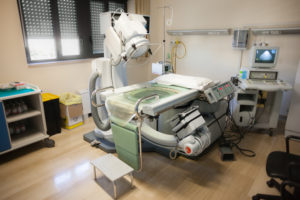Removing kidney stones.
There are several treatment options for kidney stones that are meant to break up, remove, or bypass them. The appropriate treatment method will be selected based on the stone size, number of stones, location of the stone, and the patient’s symptoms.
Treatment options for kidney stones
Ureteroscopy – This procedure can be used to remove or break up stones that are located anywhere between the kidneys and bladder. A ureteroscope, a fiber optic instrument resembling a long, thin telescope, is inserted through the urethra and bladder to the stone. The ureteroscope has a camera that allows the Urologist to see the stone, as well as a working channel in which tiny instruments pass through. Once the stone is located, the Urologist can break the stone up into dust sized particles, using a laser or other fragmenting device. A Ureteroscopy is performed under general or spinal anesthesia on an outpatient basis.
Percutaneous Nephrolithotomy (PCNL or tunnel surgery) – This percutaneous (through the skin) removal of kidney stones is accomplished by making a small cut through the patient’s back. This incision creates a narrow tunnel through the kidney to location of the stone. By feeding a special instrument through the tunnel, the surgeon finds and removes the stone. This treatment can achieve the best stone-free outcome in the treatment of very large stones that are located within the kidney. PCNL is performed under general anesthesia.
Shockwave therapy – Extra-corporeal shockwave lithotripsy (ESWL) is performed using a machine called a lithotriptor, and has been available in the United States since 1984. This is a minimally invasive procedure in which shockwaves are directed at the stone to break it down. Once broken into small pieces, the stone can usually pass out of the body unaided.
Open or Laparoscopic Surgery – This is a surgical procedure that requires general anesthesia. At the beginning of the procedure, an incision is made in the patient’s back or abdomen. Based on the stone’s location, an opening will then be made in the ureter or kidney in order to physically remove the stone(s). Once removed, the opening will be repaired.
If you are experiencing kidney stone symptoms, or have a history of stone formation, contact Urology Austin to schedule an appointment.

